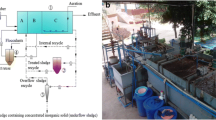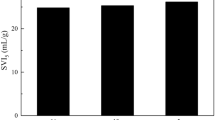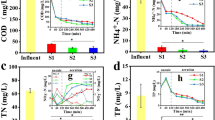Abstract
Insufficient influent carbon source affects the performance and stability of the biological nutrient removal (BNR) process in wastewater treatment plants (WWTPs). To solve this problem, a side-stream activated sludge hydrolysis (SSH) process that utilizes the internal carbon source through hydrolysis and fermentation of return activated sludge (RAS) was proposed as an alternative. In this study, two laboratory-scale pilot reactors were run to compare the pollutant removal performance in SSH and conventional anaerobic/anoxic/aerobic (A2/O) processes at various influent food-to-microorganism (F/M) ratios (0.07–0.71). When the average F/M ratio increased to > 0.35, the chemical oxygen demand (COD), ammonia (NH4+-N), total nitrogen (TN), and total phosphorus (TP) removal efficiencies in SSH reactor reached ~ 94%, > 95%, > 90%, and > 85%, respectively. Under the same influent conditions, the TN removal in SSH reactor was 23% higher than that in A2/O reactor, which is related to the additional carbon generated via RAS fermentation and mitigated substrate competition among various heterotrophic organisms. A relatively high polyphosphate accumulating organism (PAO) activity was also observed in SSH reactor. Meanwhile, the relative abundances of denitrifiers (e.g., Thiothrix, Azospira, and Dechloromonas) and PAOs (i.e., Accumulibacter, Tetrasphaera, and Dechloromonas) were higher in SSH reactor than those in A2/O reactor. These results will provide a better understanding of the mechanisms involved in SSH process, leading to more effective nutrient removal for treating wastewater with limited carbon sources.








Similar content being viewed by others
Explore related subjects
Discover the latest articles and news from researchers in related subjects, suggested using machine learning.References
APHA (2017). Standard methods for the examination of water and wastewater, 23rd ed. American Public Health Association
Barnard J, Abraham K (2006) Key features of successful BNR operation. Water Sci Technol 53:1–9
Barnard JL, DunlapSteichen PM (2017) Rethinking the mechanisms of biological phosphorus removal: Barnard et al. Water Envrion Res 89:2043–2054
Barnard J, Houweling D, Analla H, Steichen M (2010) Fermentation of mixed liquor for phosphorus removal. Proc Water Environ Fed 2010:59–71
Basuvaraj M, Fein J, Liss SN (2015) Protein and polysaccharide content of tightly and loosely bound extracellular polymeric substances and the development of a granular activated sludge floc. Water Res 82:104–117
Cao Y, Van Loosdrecht M, Daigger G (2020) The bottlenecks and causes, and potential solutions for municipal sewage treatment in China. Water Pract Technol 15:160–169
Carpenter SR (2008) Phosphorus control is critical to mitigating eutrophication. Proc Natl Acad Sci 105:11039–11040
Gu AZ, Saunders A, Neethling J, Stensel H, Blackall L (2008) Functionally relevant microorganisms to enhanced biological phosphorus removal performance at full-scale wastewater treatment plants in the United States. Water Envrion Res 80:688–698
Kim B-R, Shin J, Guevarra RB, Lee JH, Kim DW, Seol K-H, Lee J-H, Kim HB, Isaacson RE (2017) Deciphering diversity indices for a better understanding of microbial communities. J Microbiol Biotechn 27:2089–2093
Kuba T, van Loosdrecht MCM, Heijnen JJ (1996) Phosphorus and nitrogen removal with minimal COD requirement by integration of denitrifying dephosphatation and nitrification in a two-sludge system. Water Res 30:1702–1710
Lawson CE, Strachan BJ, Hanson NW, Hahn AS, Hall ER, Rabinowitz B, Mavinic DS, Ramey WD, Hallam SJ (2015) Rare taxa have potential to make metabolic contributions in enhanced biological phosphorus removal ecosystems. Environ Microbiol 17:4979–4993
Mandel A, Zekker I, Jaagura M, Tenno T (2019) Enhancement of anoxic phosphorus uptake of denitrifying phosphorus removal process by biomass adaption. Int J Environ Sci Te 16:5965–5978
McIlroy, S.J., Saunders, A.M., Albertsen, M., Nierychlo, M., McIlroy, B., Hansen, A.A., Karst, S.M., Nielsen, J.L., Nielsen, P.H., (2015) MiDAS: the field guide to the microbes of activated sludge. Database
Nascimento AL, Souza AJ, Andrade PAM, Andreote FD, Coscione AR, Oliveira FC, Regitano JB (2018) Sewage sludge microbial structures and relations to their sources, treatments, and chemical attributes. Front Microbiol 9:1462
Navada S, Knutsen MF, Bakke I, Vadstein O (2020) Nitrifying biofilms deprived of organic carbon show higher functional resilience to increases in carbon supply. Sci Rep UK 10:1–11
Nierychlo M, Andersen KS, Xu Y, Green N, Jiang C, Albertsen M, Dueholm MS, Nielsen PH (2020) MiDAS 3: An ecosystem-specific reference database, taxonomy and knowledge platform for activated sludge and anaerobic digesters reveals species-level microbiome composition of activated sludge. Water Res 182:115955
Onnis-Hayden A, Srinivasan V, Tooker NB, Li G, Wang D, Barnard JL, Bott C, Dombrowski P, Schauer P, Menniti A (2020) Survey of full-scale sidestream enhanced biological phosphorus removal (S2EBPR) systems and comparison with conventional EBPRs in North America: process stability, kinetics, and microbial populations. Water Envrion Res 92:403–417
Petriglieri F, Singleton C, Peces M, Petersen JF, Nierychlo M, Nielsen PH (2021) Candidatus Dechloromonas phosphoritropha and Ca. D. phosphorivorans, novel polyphosphate accumulating organisms abundant in wastewater treatment systems. ISME J 15:3605–3614
Qu J, Wang H, Wang K, Yu G, Ke B, Yu H-Q, Ren H, Zheng X, Li J, Li W-W (2019) Municipal wastewater treatment in China: development history and future perspectives. Front Environ Sci Eng 13:1–7
Ren J, Cheng W, Wan T, Wang M, Jiao M (2018) Effect of aeration rates on hydraulic characteristics and pollutant removal in an up-flow biological aerated filter. Envrion Sci Water Res 4:2041–2050
Ren J, Cheng W, Wan T, Wang M, Meng T, Lv T (2019) Characteristics of the extracellular polymeric substance composition in an up-flow biological aerated filter reactor: the impacts of different aeration rates and filter medium heights. Bioresource Technol 289:121664
Richard, M., Brown, S., Collins, F., (2003). Activated sludge microbiology problems and their control, 20th Annual USEPA National Operator Trainers Conference, pp. 1–21.
Rittmann BE, Mayer B, Westerhoff P, Edwards M (2011) Capturing the lost phosphorus. Chemosphere 84:846–853
Schellenberg T, Subramanian V, Ganeshan G, Tompkins D, Pradeep R (2020) Wastewater discharge standards in the evolving context of urban sustainability–the case of India. Front Environ Sci Switz 8:30
Smolders G, Van der Meij J, Van Loosdrecht M, Heijnen J (1994) Model of the anaerobic metabolism of the biological phosphorus removal process: stoichiometry and pH influence. Biotechnol Bioeng 43:461–470
Tooker NB, Li G, Bott C, Dombrowski P, Schauer P, Menniti A, Shaw A, Barnard JL, Stinson B, Stevens G (2017) Rethinking and reforming enhanced biological phosphorus removal (EBPR) strategy–concepts and mechanisms of side-stream EBPR. Proc Water Environ Fed 2017:2547–2564
Vollertsen J, Petersen G, Borregaard VR (2006) Hydrolysis and fermentation of activated sludge to enhance biological phosphorus removal. Water Sci Technol 53:55–64
Wang D, Tooker NB, Srinivasan V, Li G, Fernandez LA, Schauer P, Menniti A, Maher C, Bott CB, Dombrowski P (2019) Side-stream enhanced biological phosphorus removal (S2EBPR) process improves system performance—A full-scale comparative study. Water Res 167:115109
Wang D, Li Y, Cope HA, Li X, He P, Liu C, Li G, Rahman SM, Tooker NB, Bott CB, Onnis-Hayden A, Singh J, Elfick A, Marques R, Jessen HJ, Oehmen A, Gu AZ (2021) Intracellular polyphosphate length characterization in polyphosphate accumulating microorganisms (PAOs): implications in PAO phenotypic diversity and enhanced biological phosphorus removal performance. Water Res 206:117726
Wilfert P, Kumar PS, Korving L, Witkamp G-J, Van Loosdrecht MC (2015) The relevance of phosphorus and iron chemistry to the recovery of phosphorus from wastewater: a review. Environ Sci Technol 49:9400–9414
Wu D, Zhang Z, Yu Z, Zhu L (2018) Optimization of F/M ratio for stability of aerobic granular process via quantitative sludge discharge. Bioresource Technol 252:150–156
Zilles JL, Peccia J, Kim M-W, Hung C-H, Noguera DR (2002) Involvement of rhodocyclus-related organisms in phosphorus removal in full-scale wastewater treatment plants. Appl Environ Microb 68:2763–2769
Acknowledgements
This work was supported by the National Natural Science Foundation of China (No. 52070156), the Scientific Research Project Funded by the Shaanxi Provincial Education Department (No. 17JS097), the Scientific Research Project for Returned Overseas Scholars in Shaanxi Province of China, and the Qinchuangyuan Project for the Team of Scientists and Engineers in Shaanxi Province of China (2022KXJ-115).
Author information
Authors and Affiliations
Contributions
Zhimin Guo, Jinglin Zhang, Penghai Xu, Yulong Liu, and Xiaosheng Jing processed the experimental data and investigation process. Zhimin Guo was a major contributor to writing the manuscript. Zhimin Guo, Zhe Zhang, Lu Qin, Guodong Chai, and Taotao Lv performed the analysis and designed the figures. Xing Zheng was involved in supervision, resources, and project administration. Dongqi Wang participated in conceptualization, validation, writing, review, editing, and funding acquisition. All authors provided critical feedback and helped shape the research, analysis, and manuscript.
Corresponding author
Ethics declarations
Conflict of interest
The authors declare that they have no conflict of interest.
Additional information
Editorial responsibility: Jing Chen.
Supplementary Information
Below is the link to the electronic supplementary material.
Rights and permissions
Springer Nature or its licensor (e.g. a society or other partner) holds exclusive rights to this article under a publishing agreement with the author(s) or other rightsholder(s); author self-archiving of the accepted manuscript version of this article is solely governed by the terms of such publishing agreement and applicable law.
About this article
Cite this article
Guo, Z., Zhang, J., Xu, P. et al. Performance and microbial dynamics of side-stream activated sludge hydrolysis process at different influent food-to-microorganism (F/M) ratios. Int. J. Environ. Sci. Technol. 20, 11029–11040 (2023). https://doi.org/10.1007/s13762-022-04659-x
Received:
Revised:
Accepted:
Published:
Issue Date:
DOI: https://doi.org/10.1007/s13762-022-04659-x




